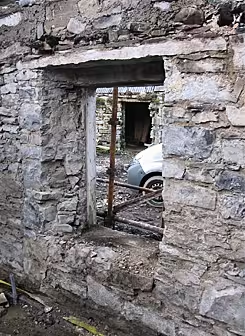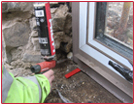
Construction sequence can save you lots of your free time donated to a self build. It was there for important that the cottage concrete floor would be poured directly from the shoot of the concrete truck through the empty window openings before the windows were fitted saving time double moving concrete in wheel barrows into the building.
Selecting Windows
Like all things construction selecting a window specification can be a mine field. They are an item that needs to last to get good value from them so putting in cheap windows is a bad idea. Invest in a good complete frame and glass U Value 1.2 w/sqmk is a good mid range U value, with an air tightness of 600pa. For passive standard you would look to achieve a U value of 0.8 w/sqmk or better. Most windows come with warm edge spacers these days and triple glazed windows can cost 8 to 15% more than double glazed. In most cases it is better value to upgrade your walls that up grade your windows.
- Discuss your glass alternatives with the supplier as upgrading from argon to krypton can increase your u value significantly.
- I am not a fan of uPVC and prefer aluminium or wood windows, although the latter require more maintenance especially in costal area. Aluminium and wood tend to be sturdier especially if you are in a windy location. In the end I chose an aluminium triple glazed system from APA Systems with glass supplied by Glas seal.
- Advice the window supplier of the location of your home as this will affect the paint specification and cost. In costal areas like mine you must go with a marine grade paint specification.
- Issue the window supplier with a plan and request that they check your dimensions for compliance with Part B fire of the building regulations.
- Consider allowing for future installation of External Insulation, to achieve this as in my case Installed 50mm Kingspan K12 insulation with a Aluminium Angle to the head cill and jambs of the windows so that I could rap the external insulation into the window and prevent a nasty cold bridge in the future. It cost about 500 euro extra but will be worth it in the future when I go to install the exterior insulation.
Measuring the window Openings
If you can remove the existing windows and measure the window opening in three locations top and sides and take the minimum, also check the diagonals to see if the opening is square. If you cannot remove the existing windows you can always assume a 10-15mm gap on the side and top of the windows.
Make sure to note clearly to the window supplier that the windows are site opening sizes and agree a tolerance with them to allow the window to easily fit in.

Installing windows
When taking the delivery of the windows to site check each windows glass and frame for any damage. Once they have left they are yours … and they will not take responsibility for any damage. The best motto is to “store the windows in there openings” that have they laying around site. Fit them off the truck because with people and tools around windows will get damaged.
- Clean and prepare your openings so that the glass will go in one movement. Ask the supplier to give you some plastic packers 1mm to 10mm in size to fit around the windows where required to get a tight fit.
- When in place check the level on the horizontal and vertical, if you need to gently persuade the window in to place use a hammer lightly over a piece of wide wood to prevent dints.
- The windows come with angle cleats to fix the window to your walls. In my case with stone walls I could not get a fixing and did not use angle cleats. To achieve a fixing I sprayed the gaps with a little water and pump the gaps with expanding foam to fix the window in place. The water helps the expanding foam to get better adhesion. I used expanding foam from Hilti which unlike standard foam has a higher density and only expands to the volume of the space. It is more expensive however it will provide a better fixing and save me cleaning of lumps of foam.
- When the windows are installed, and you have a dry day point the outside of the windows with a silicone mastic joint with a matching colour to your windows. This is tricky for first timers so start on a window that will not be seen.
Stay tuned to my next blog sequence where finally I will have a sealed building. “Installing an new roof on a old building”
Useful Links








